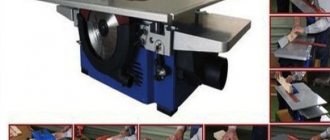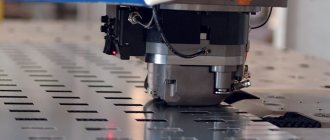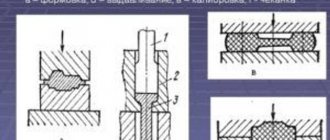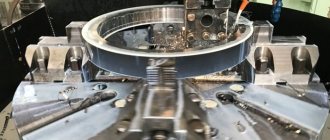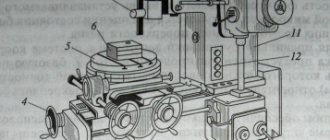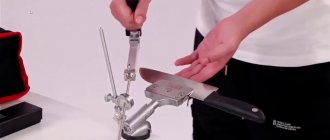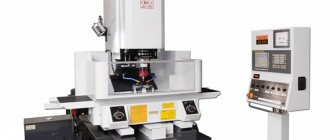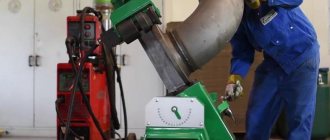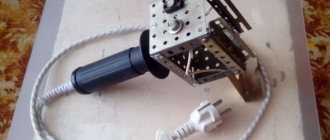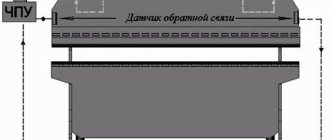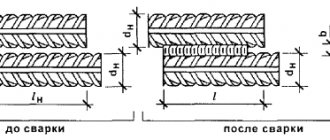Equipment design
An automatic lathe, like other industrial equipment, consists of several units. All of them are interconnected by additional mechanisms and elements (belts, wires, gears, shafts). The workpiece is processed using a spindle and a workpiece clamp (support). Machines equipped with a CNC system have the following design:
- The basis for the arrangement of the remaining parts is a cast frame. Guides for the movement of the headstock are fixed on it.
- A movable headstock on which the hollow spindle and collet clamp are fixed.
- Fixed supports for securing the incisors.
- A device through which rod blanks are fed.
Modern machines contain additional elements:
- supplies store;
- cooling system;
- modernized management system;
- chip removal mechanism;
- a conveyor along which finished workpieces are moved.
Additional elements include protective shields, lighting, and a turret for performing additional operations with workpieces. This can include drilling, turning, milling and threading.
Evolution of development
During their evolution, swiss type machines turned from manual to semi-automatic, and then, when electronics were sufficiently developed, it was possible to create fully automatic models equipped with computer numerical control (CNC). And although semi-automatic machines are still produced today, manufacturers in most cases tend to purchase a CNC bar lathe: the price of such a unit is quite high. But on the other hand, it does not require the constant presence of a worker and ensures the highest processing accuracy, since the influence of the human factor is completely eliminated.
In addition, the CNC system, which is essentially a computer, is capable of giving the cutting tool the most complex movement that a person is simply incapable of. For example, carve a perfectly spherical surface.
Main functions
An automatic lathe is used in the serial production of small parts. This is due to the high performance of the equipment. The machines are capable of processing up to 20 parts per minute. The devices are intended for the manufacture of axles, crossbars, bushings, collets, hollow cylinders, and shafts. Purpose:
- drilling;
- cutting internal and external threads;
- milling of metal surfaces;
- engraving.
CNC Bar Lathe
CNC bar lathe is widely used in enterprises of various industries, for example, in mechanical engineering and metalworking. This equipment is simply irreplaceable during the production of automotive parts, medical components, small watch parts, furniture fittings, components for electrical equipment and hydraulics. A distinctive feature of CNC bar lathes is that its working tool makes exclusively transverse movement. Only the workpiece itself moves longitudinally. The processing process is carried out very close to the fastening area of the future part. This ensures constant and stable rigidity in the cutting area. Because of this feature, the extreme precision of the machining process is also ensured. It is also worth noting the fact that in CNC bar lathes, the workpiece, which is clamped in a collet or chuck, is processed using a linear or driven tool. This tool is capable of performing both longitudinal and transverse movements. Before you start working on this machine, you must remember that for the correct, and most importantly, long-term operation of this equipment, you need special raw materials: calibrated rod. The rod for the machine must have a straightness of at least 0.5 mm with a length of 1 m and a diameter of at least 0.1 mm. If you use a low-quality or uncalibrated rod, the machine breaks down very quickly and sometimes cannot even be repaired. Many professional engineers recommend using imported rods during work, since their calibration and grinding are extremely accurate, unlike domestic ones. The main advantages of CNC bar lathes are reliability and long service life; accuracy and cyclicality in work; wear resistance to mechanical damage; fast workpiece processing time; compact size and light weight; extremely accurate device indexing; equipment of this type is capable of processing parts with small diameter; drive mechanism. Naturally, this is not a complete list of the advantages of CNC bar machines. But we can say with certainty that by purchasing such devices from official dealers of leading manufacturers, you will not only improve your own production, but also increase its productivity and reduce the load on the operator during operation. For more than 10 years, it has been supplying the best machines from EMCO to Russia. WE are official dealers, which means that we will help you put the machine into operation as efficiently as possible and provide full service support throughout the entire service life of the machine.
Advantages
Automatic lathes have a number of advantages that manufacturers value:
- Functionality. The presence of a large number of moving axes and working heads allows for various operations without constant reconfiguration of the equipment.
- High precision of finished workpieces.
- Low roughness of the processed surface.
- The CNC lathe has high productivity.
An automated machine must be operated by a knowledgeable person. He needs to understand how to set up and repair equipment.
CNC lathe
CNC automatic longitudinal turning - for those who value reliability.
Automatic longitudinal turning machines are, first of all, characterized by their highest productivity in the process of high-precision machining of complex parts. Such equipment can process metal products made from any metal: from soft ones, such as copper, to hard ones, such as alloy steel.
CNC automatic longitudinal turning machines are modern, high-tech equipment at a fairly low price. The use of a modern CNC device allows you to readjust the machine for processing a new part in the shortest possible time; you just need to set the appropriate program. Parts processed on a CNC lathe are distinguished by high accuracy and dimensional stability in serial and large-scale production.
Classification
Due to the variety of types of automatic lathes, it is difficult for a person without experience to distinguish between them. Several classifications have been created for this purpose. They indicate the differences between machines in terms of operations performed or design.
By purpose
Any industrial equipment can be divided by purpose. There are two types of automatic lathes:
- Specialized - used when carrying out a specific operation with a workpiece. Cannot be reconfigured.
- Universal - equipment that can perform various operations with workpieces.
There are also semi-automatic machines that are used for the manufacture of piece parts.
By spindle location
If we talk about the location of the working part of the automatic lathe, we can distinguish two designs:
- vertical spindle;
- horizontal spindle.
The movement of key equipment elements and the machining process itself depend on the location of the spindle.
By number of spindles
The devices also differ in the number of moving elements:
- single-spindle - designed for processing one workpiece;
- multi-spindle - can process several workpieces at the same time.
There are several types of single-spindle machines. Each of them is a separate structure that performs certain operations.
Single spindle machine
Shaped-cutting
Shaping and cutting machines are used for the production of short workpieces that have a small diameter. The output is a simple form. The principle of operation is that the workpiece is fixed in a rotating spindle. To process the part, cutters are fixed in the supports. The number of calipers can reach 4. They can be moved in the transverse direction. New models have special guides that allow you to move the caliper along the spindle axis.
Additionally, a stop is installed in shaping and cutting machines. It can be moved to increase or decrease the length of the workpiece.
Longitudinal turning
An automatic longitudinal turning machine is used in the production of long parts with a small cross-section from a metal rod. Used in enterprises involved in instrument making or watch production. Using a collet chuck, the workpiece is secured in the spindle. It is mounted on a movable headstock, which moves along guides. The incisors remain motionless. They are firmly fixed in the calipers.
Additionally, special devices can be installed opposite the workpiece, with the help of which various operations are performed. These include drilling, tapping and countersinking. The spindle can be equipped with a separate drive, which will provide translational movements.
Turning and turret
Automatic turning-turrets are used in production for the manufacture of products of complex shapes. When working, a metal rod is used. Some models are designed for creating piece blanks. A metal product or rod is fixed in a movable spindle. The turret starts to move automatically. The calipers perform transverse movements.
Advantages of the automatic longitudinal turning machine
The installations are widely used in medium and large industries, where low production costs, high quality and productivity are important. In addition, the equipment is excellent for the manufacture of parts that differ from each other in a small number of parameters. At the same time, an enterprise can expand its product range through cams, collets and other tools that can be purchased during operation. In general, the automatic longitudinal turning machine is becoming an important part of the production cycle in many enterprises and factories. Among the strengths of the equipment are also:
- High quality of manufactured metal products. The manufactured products have a smooth surface and do not require additional processing.
- Simplify the production of complex parts. The machine is characterized by great freedom of action. For example, you can perform milling both along the axis of the workpiece and across it.
- Demand in high-tech industries. The installation allows you to obtain conical and shaped surfaces.
- Simplification of labeling. An automatic longitudinal turning machine can roll small letters and numbers onto parts.
To find out the price of equipment from the catalog, contact our manager at the phone number listed on the website. 100% of the sales department employees are technical specialists. We are ready to perform a set of design calculations for a new production or modernization of an existing production line, as well as select machines to solve specific problems.
Multi-spindle
Multi-spindle automatic lathes are used for multi-batch production of various parts. Used for drilling, cutting internal and external threads, turning, trimming workpieces.
The equipment contains a movable shaft on which special cams are fixed. When the shaft begins to rotate, a complex of movements occurs.
There are two groups of multi-spindle machines:
- parallel;
- consistent.
The designs also differ in the type of fastening of the cams to the rotating shaft:
- Drum - when the shaft rotates, the cams control all movements of the machine. The design is a cylinder on which overhead cams are fixed.
- Disk - such designs are installed in semi-automatic machines. They drive calipers with cutters and turret heads.
Multi-spindle equipment is considered universal and multifunctional. On automatic lathes of this type, several supports are installed into which the cutters are fixed. Such a machine can simultaneously perform several operations.
Multi-spindle equipment
